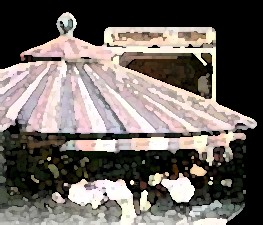|
More about the early days:
The old Feltman carousel had very unusual horses on it. Some of them had
internal lightbulbs which illuminated the jewels on the horses. The Feltman
carousel had two very spectacular band organs. One was a huge 94 key style
Selection Gebruder Bruder which featured an actual mechanical orchestra with
small animated musicians. According to the late Edo McCollough, it was the
loudest organ in Coney Island and could be heard for blocks down Serf Avenue.
The organ has been fully restored and is in a museum in
Germany in the state of Baden. It is a spectacular organ! The other Bruder was an
early 80 key organ with mechanical dancing couples on top of the organ. This organ
survives and is in a collection in the Chicago area. It is fully restored.
These organs were sold to Feltman by William F. Mangels. He by the way, had a museum
filled with Coney Island artifacts which opened in the late 1930's. This museum was
sold to the Horn Brothers of Sarasota around 1958. Mangels gave the paper archives to
Fred Fried which are now at the Smithsonion. A friend who drove Fred Fried to Mangels
to pick up the paperwork left with a treasure, the first known Coney Island made roller
coaster car which I later acquired from him along with his large 110 key Gavioli band
organ. ou can see the Gavioli at the following website:
http://mmd.foxtail.com/Pictures/EuclidBeachGavioli.html
The B.A.B. Organ Company of Brooklyn maintained many of the band organs at Coney Island.
In 1958 the B.A.B. Organ Company was purchased by Senator Charles Bovey and was moved to
Virginia City, Montana. Mr. Bovey bought Virginia City and Nevada City, Montana to use as
a museum. The organ collection was put in a building in Nevada City, Montana where
it exists to this day. Part of the B.A.B. purchase was the purchase of the complete
Molinari Organ Company workshop. Molinari made monkey organs for the streets of New
York. By the way in the early days, Irving Berlin would visit these people to have some of
his earliest songs pinned on the cylinders! The collection is now owned by the state of
Montana.
Tim Trager Trager@idt.net
(reprinted with permission)
|

